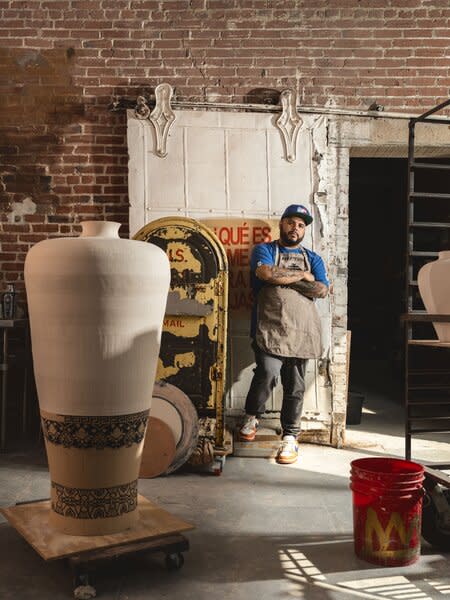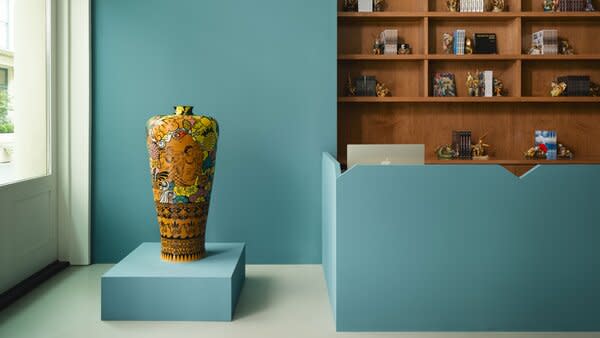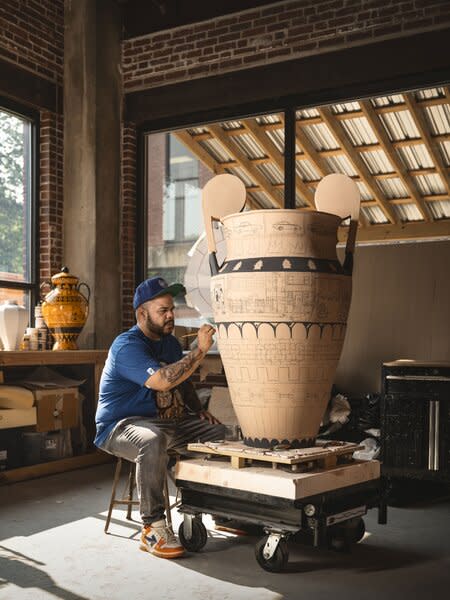Roberto Lugo Is Using a Greco-Roman Pottery Tradition to Tell His Own Stories
- Oops!Something went wrong.Please try again later.
In his first solo gallery show in New York, the Philadelphia ceramicist plays with ancient motifs to recount his childhood struggles and obsessions.

You might not have heard of Roberto Lugo, but you’ll likely know some of the people the Puerto Rican–American ceramicist paints onto his raucously colorful pottery: Evander Holyfield, Russell Simmons, and Cuban singer Celia Cruz, to name a few. In the pieces, Lugo also likes to incorporate imagery or sculptural elements that have made his heroes famous: In one example, created as part of his "Stunting" Garniture Set, from 2019, an urn commemorates Louis Armstrong with a handle fashioned after his trumpet.
If you have heard Lugo’s name, it could be because of the rousing part spoken-word performance, part sermon he delivered at a Rhode Island arts conference in 2015. The then-emerging artist shared how ceramics transformed his life, and ultimately gave him a voice to elevate others within the Black and Afro-Latino communities. "I realized early on that people look at you for what you are on the outside and make all these judgments… I was a brown person," said Lugo at the conference, remarking on his upbringing in Northern Philadelphia where he was exposed to hardships including gang violence and excessive discrimination. "The [pottery] wheel, however, gives me an opportunity to take all those things, all the things that happened to me, and make something out of it—make something out of myself."
Growing up in Philadelphia’s Kensington neighborhood, as his hard-working immigrant parents struggled to make ends meet, Lugo found solace in music, sports, and his first creative outlet, graffiti. His tag, Robske, a moniker he still uses today, could be found everywhere. A move to South Florida led him to take drawing classes at a local community college, where he eventually discovered—and fell in love with—ceramics, forever changing his life.
Later, while earning his Bachelor of Fine Arts at Kansas Art Institute and Master of Fine Arts at Penn State, the artist honed his skills by adopting and riffing on the ancient tradition of painted pottery he discovered in art history courses. Since then, it has allowed him to reclaim spaces society has otherwise barred his community from accessing and to suggest different historical narratives. His ability to mold clay into vessels with a message has turned him into a sought-after talent across the fine art, craft, and collectible design worlds.
Though recognition from collectors, gallerists, museum curators, and fellow artists has brought him to different parts of the world, Lugo remains rooted in Kensington. A social activist, he’s launched a number of initiatives that empower local residents to discover their own creative potential. As a professor at the Tyler School of Art, a university in the city, Lugo hosts exhibitions, lectures, and workshops, all of which have made him an important force in the American craft revival movement.
Now, Lugo has launched his first solo show in New York, The Gilded Ghetto, on view at R & Company until October 27. The exhibition includes three new bodies of work and an immersive installation, all stemming from the artist’s return to personal introspection and stories from his past that have been hard to share before, he says. Framed through his personal lens, the works are also meant to bring a fresh awareness to some of the challenges American society has long faced, including systemic racism and economic disparity. We spoke to Lugo about where he started, how he approaches the pottery wheel, and why he pulled from his own past for the new work.
Dwell: What drew you to ceramics initially?
Roberto Lugo: Because of my background in graffiti, I started out in college taking a drawing class, and eventually came into contact with ceramics. Seeing how people would always spend lots of time in the pottery studio because of the equipment needed to make the work, and how this fostered community, I was quickly drawn to it.
Starting to work in this medium instead [of drawing], I was confronted with a level of dissonance, connection, and disconnection. In one sense, working with my hands and making things felt familiar, but in another sense, the idea of being able to do so freely and make art felt like something that I wasn’t supposed to be doing. For so long, the idea of physical work for me was linked with producing usable products. Every time I was making something on the wheel, It felt like I was doing something I never imagined I could do. It opened me up to new ways of thinking, mainly the idea that ceramics could be both functional and a medium to express different ideas.
See the full story on Dwell.com: Roberto Lugo Is Using a Greco-Roman Pottery Tradition to Tell His Own Stories




